I wouldn’t last ten minutes on a farm. The cows would revolt by tipping themselves over on a regular basis…the rooster would crow throughout the night…the sheep would form a circle around me and take turns headbutting me in the behind…it wouldn’t be pretty. Luckily, I can experience the joys of being a farmer without all of the hard work that goes with it…that is…if you don’t count the time you spent trying to make sense of the manual.
Before I begin with the review, it must be mentioned that Agricola is not pronounced like it is spelled. You can listen to the actual pronunciation here:
Agricola is Latin for farmer. You may now feel enlightened.
I should also mention at this point that I played via the family rules, which leaves out the occupation and minor improvement cards. I know how much some people get their panties in a bunch when they find out that I didn’t quote unquote “play the game”, which is code for, “play the variant that they liked the best.” So…put your coke bottle glasses back on there, Sparky…go ask your mom to make you some Hot Pockets, it’ll be OKAY.
Now that THAT is out of my system…Agricola is a game where players are tasked with building the best farm. At the end of the game, you’ll be “graded” on various aspects of your farm. Neglect a whole area completely (like not plowing any fields) and you’ll be docked points…by the same token, you can score some major points by knocking a particular statistic (like raising a crapton of sheep) out of the park.
Agricola has a LOT of pieces and a LOT of playing boards. To top that off, the playing boards are two-sided…it might take new players a while to figure out which is which for the game setup. I had to turn to YouTube myself as the manual was only partially helpful. I recommend clearing a lot of space on your table or playing on a larger surface…the main board takes up a lot of room.
Components
To aid new players or interested parties in what you’ll need to set the game up, I’ve included a brief description of the components below.
Animals – The white, brown, and black cubes included in the game represent sheep, cattle, and wild boar, respectively.
Resources – You’ll find that there are a bunch of resources in the game, represented by small, round wooden counters:
Yellow = Grain, Orange = Vegetables, Brown = Wood, Dark Red = Clay, Black = Stone, White / Tan = Reed
Player Tokens, Fences, and Stables – The large wooden discs represent your family members. You start off with two. Fences are in the shape of thin “sticks” and the stables look like small houses. All of these playing pieces are of a particular color and go to whichever player plays as that color.
Food Markers – Food is represented by small, yellowish tokens with the number “1″ on them…this stands for, “1″ food. The game includes multiplayer tokens should you run out of “1′s”.
House & Field Tiles – The two-sided square tokens found in the game are a mix of things. One token has a wooden house / room on one side and a clay house / room on the other side. The other square token has a stone house / room on one side and a field for growing crops on the other. The fact that they are two-sided doesn’t mean anything in terms of game mechanics…take what you need when you need it, as appropriate.
Occupation and Minor Improvement Decks – There are a set of decks that include both occupation cards and minor improvement cards. You’ll see them represented by the letters, “E”, “I”, and “K”. Pick ONE deck to use and put the rest back in the box. I recommend the “E” deck for beginners. When playing the family version of the rules, occupation and minor improvements cards are NOT used.
Occupation Cards – The yellow occupation cards are divided into three sets. 1+ cards are used when playing with 1-5 players, 3+ cards are used when playing with 3-5 players, and 4+ cards are used when playing with 4-5 players. So, if you had 4 players…you’d use all three decks. If you had 3 players, you’d only use the 1+ and 3+ decks.
Minor Improvement Cards – The orange minor improvement cards don’t have any subcategories so you can rest easy there. Just use the whole set of cards under whichever deck you’ve chosen.
Round Cards – The blue round cards are dealt on the main playing board on their appropriate spaces. For example, the four Stage 1, Round 1-4 cards are placed on the matching four spaces on the main board, face down.
Action Cards – The green action cards are only used in the 3-5 player game. They add additional actions to the board so that players going last aren’t stuck with having to play an action that they may find unfavorable.
Begging Cards – The grey begging cards are given to players when they can’t feed their family during a harvest. They count as negative points during end game scoring.
Summary Cards – The yellow / golden summary cards lay out what possible reveals will occur during the game as round cards are flipped over. This helps players plan ahead to some degree. The other side of the card is a quick scoring guide for end game purposes.
Farmyard Boards – There are five, double-sided farmyard playing boards. Each player will receive their own. Use the plain side / the one that looks the least busy…the correct side is also the same across all five boards.
Action Boards – There are three, double-sided action board of various shapes. The board where the green action cards would go can be flipped to play with either the family rules or the regular rules. There are some default actions on this board as well. The other two boards contain your round cards, one of which contains some default actions. The reverse side of these two boards contain examples and shouldn’t be used.
Major Improvement Board / Cards – The red major improvement cards go on their matching space on the major improvement board. Players can purchase these upgrades throughout the game. Some cards are duplicate, but one card is cheaper to buy than the other. Place the cheaper upgrade down first as it will be purchased first.
Setup
Each player receives a farmyard board and two wooden house / room tokens to place on their default spaces. Players put two of their large colored discs on those two rooms.
Next, the larger action boards are setup in the middle of the table. From left to right…the major improvements board, the board with the spaces for the green action cards, the board with the Round 1 spaces, and finally the board with the round 3 spaces. In regards to the board with the spaces for the extra green action cards, make sure you are using the side that corresponds to either the family rules or the regular rules.
Deal the blue round cards on their respective round spaces. If you are playing the regular version of the rules, players receive seven occupation and seven minor improvement cards. As I mentioned before, I played the family version of the rules and thus am reviewing that variant…so you won’t see the occupation and minor improvement cards used in my pictures or during the review.
Players choose a starting player. They get two food, the rest get three food.
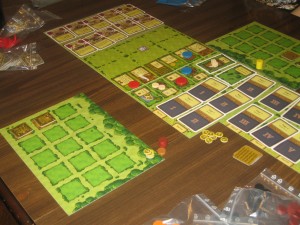
This may help a little…though I took the picture as we had just started. During the setup, the family member discs should be placed at “home”.
It sounds overwhelming, but once you get past the hurdle of figuring out how everything is set up, play is relatively easy. Below is a link to a video that helped me out tremendously with how the game is supposed to be setup.
Gameplay
The game consists of fourteen rounds. At the end of the last round, scoring occurs…whoever has the most points wins.
A round consists of the following:
1. Draw a new round card – The next facedown round card is turned over. Round cards are drawn starting from the top going down, then over one column. For example, the first column has a stage 1 card, draw that first. In the next round, draw the top card in the second column. In the next round, draw the middle card in the second column…then the bottom card…then the top card in the third column…and so on and so forth.
2. Replenish goods and animals – All action spaces that allow players to collect resources with an arrow on them get that many new resources on that space. There is no limit to how many resources a particular space may accumulate.
3. Work phase – The starting player places their first family member on one of the actions available and takes that action. Players proceed clockwise placing their first family member, taking actions. On the starting player’s turn, they place their second family member on an action space, followed by the players, clockwise. Players continue in this manner until all family members have been placed.
4. Return home – Once all family members have been placed, they return back to their home tiles.
At the end of each stage is a special harvest phase. This ONLY occurs at the end of each stage. You’ll know that it’s time for harvest by the indicators on the main board. If it’s not time for a harvest, just continue on to the next round.
The harvest consists of the following:
1. The top crop you have on your fields is removed and placed into your personal supply.
2. You feed your family by returning two food tokens per family member into the main supply. Those that don’t have enough get a beggar card…one for EACH missing food.
3. Any animals you have reproduce, assuming there is room. You must have two animals of the same type and room to allow for the new addition.
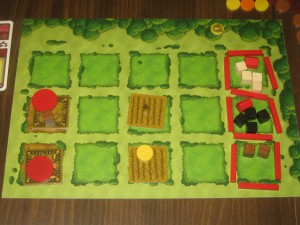
You can get food in a number of different ways. Certain actions net you food, while others allow you to convert crops or animals into food.
The Review
Yes, I am well aware that I didn’t cover everything…but the above should give you a rough idea of what you are in for.
I found the game to be hard to learn and teach to others…HOWEVER, gameplay is quick once you get over the initial learning curve. I spent about two hours reading the rules and playing a solo game just to get an idea of what gameplay is…or should be…like. Figuring out how the game was setup and actually setting up the pieces and cards took longer than the gameplay itself. Once I got into a rhythm of, new round card, replenish, place family, place family, home, new round card, replenish, place family, place family, home, oh look harvest…it wasn’t so bad.
My son and I played the family version and I won 13-11, though it was close. It took us about an hour to play and he picked up on the gameplay very quickly. It really helps to have someone who knows how everything is set up and works to get a great first time experience. During my solo game, I just blundered through rounds, ignoring the improvement cards completely until I realized that hey…maybe the furnace would help me rake in more food so I’d have more time to do other things. I didn’t “get it” until it was far too late in the game do anything about it. I think I scored a measly 1 point in that solo game…after all of the penalties I accumulated for neglecting certain scoring categories.
It’s possible that it’s because I haven’t played the game enough to come up with good strategies…but I felt…rushed. I had to make the most of every turn and by the time I could get a partial farm up and running, the game was over. Maybe I’ll develop my own variant where at the beginning of a new stage, players get a “free round” to collect more resources and do more things. I’ll have to see how it all works out…maybe I’ll play a few more solo games first to see what actions are best to take when.
The components are top-notch, though I think the manual could have done a better job in explaining the game better. The hallmark of a good manual is one that is easy to read and is a one-stop-shop place for all of your questions. I didn’t feel that this manual provided that…it could be just me.
I appreciate that they created a family version of the rules for people like me who like things to be simple on occasion. To be fair, the regular game doesn’t seem that complex as all you’re doing is adding the occupation and minor improvement cards…though they do seem to make a big difference as they alter the rules slightly. Just in glancing through them, they seem to help players specialize in certain areas…providing extra food here or extra resources there. I may try them out once I’m confident that I’ve mastered the family rules.
The one thing that makes the game feel so complex is the amount of actions you have to choose from during the family placement phase. Ironically, that was my son’s favorite part of the game…and I quote, “I get to do what I want.” Having so many options available opens up a wide array of different strategies that a player can employ…once they discover what they are.
I do recommend the game for those that aren’t afraid of a learning curve and enjoy worker placement / resource games. It may take a few games to get a feel of how of the game mechanics all work together…so don’t be discouraged by a set of crappy scores, one right after the other.
Final Verdict: 7/10

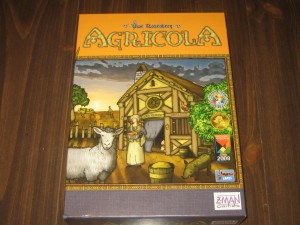
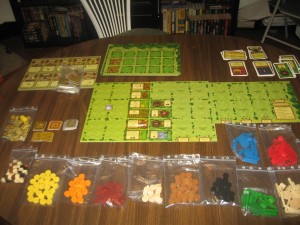
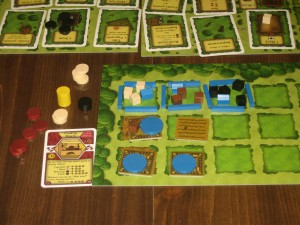
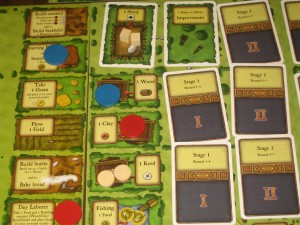
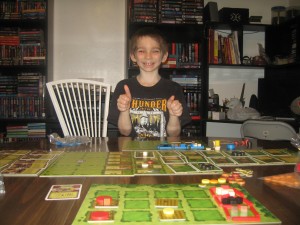
I would have to agree with practically everything you said in this review. It’s a game tthat just keeps giving. I’ve played it scores of times and its always fun.
Hi Vincent,
This is one of a handful of games that I give 10/10. If you’ve only played the family game, you really should give the full version a try. That “rushed” feeling won’t go away. It’ll still be there in the area of Round 8, but that’s just part of the fun.